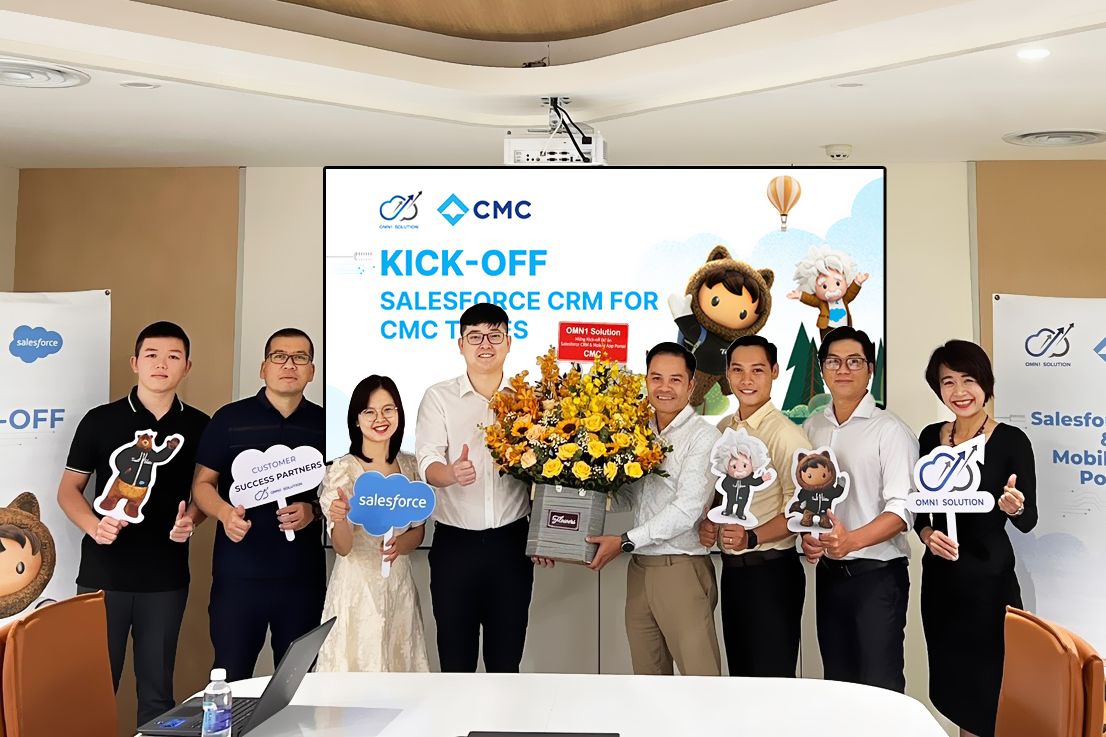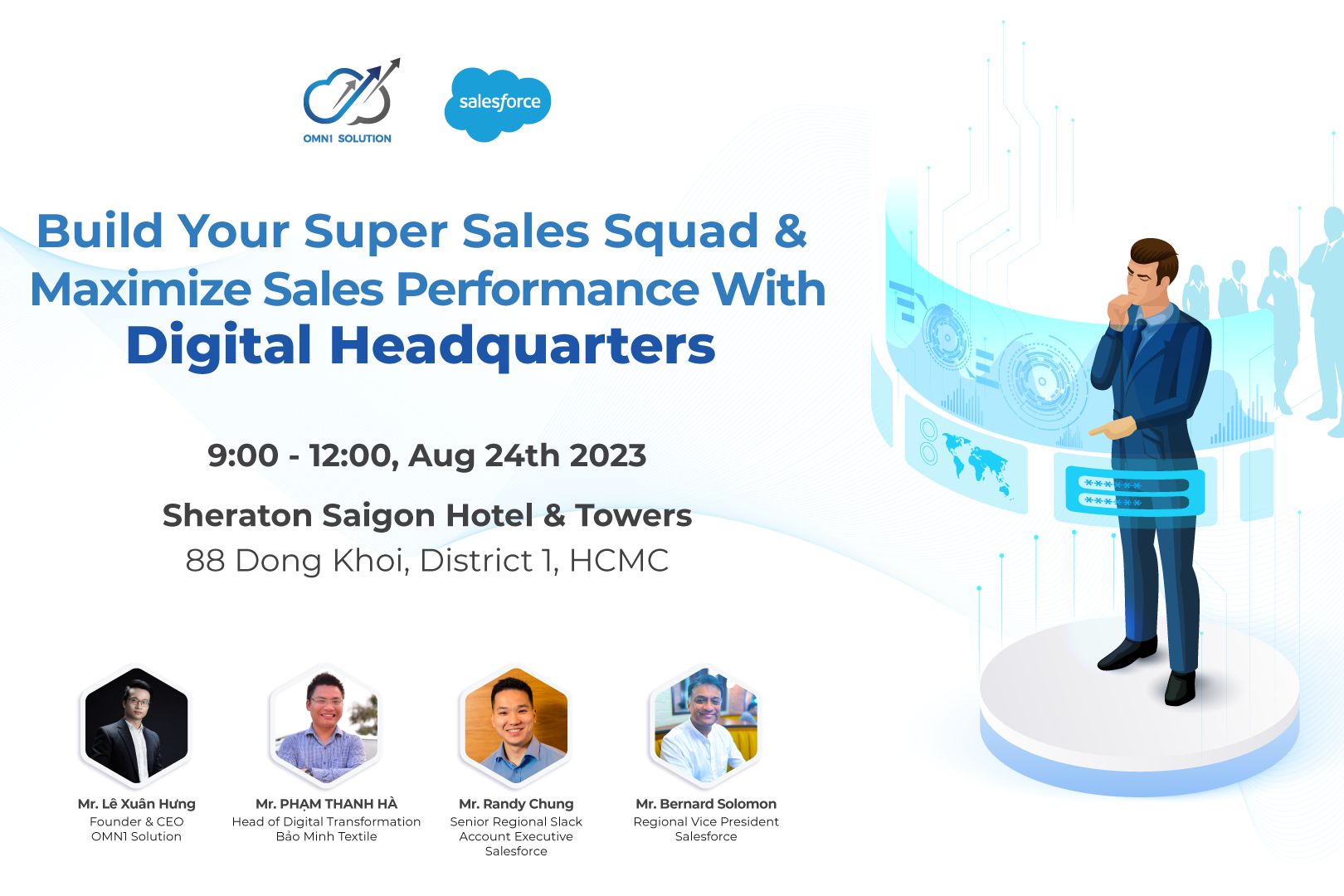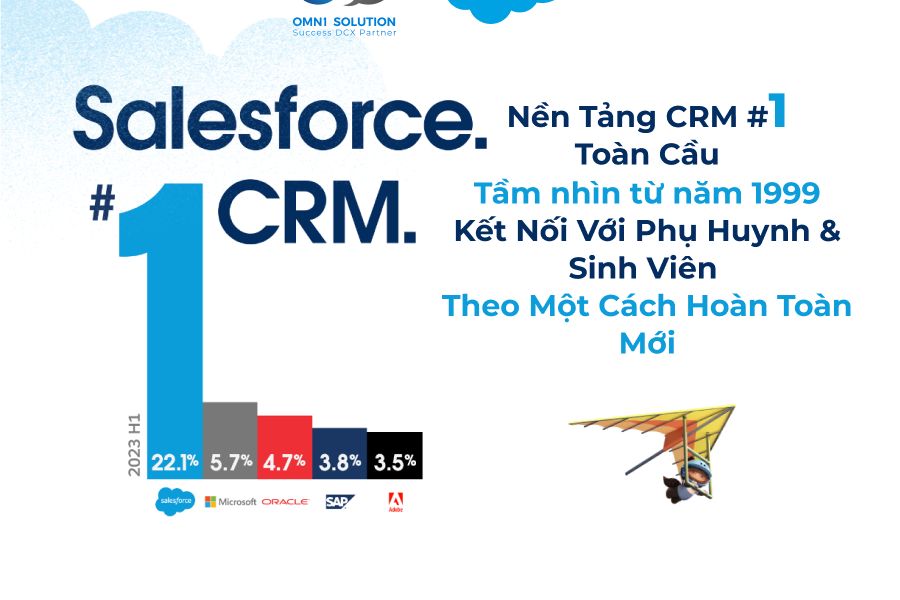The vision of a business sales team instantly accessing and fully understanding customer profiles with just a simple command is no longer a distant future. With automation support, AI is now the brain that drives B2B CRM far beyond traditional management functions.
A Modern B2B CRM Ecosystem
According to Mr. Le Xuan Hung – CEO of OMN1 Solution, the modern B2B model demands a CRM system that seamlessly manages the entire customer lifecycle.
The process begins with B2B marketing through various channels such as email marketing, websites, events, and trade shows to generate leads. Once the data is collected, businesses must nurture and engage these leads to produce a qualified pipeline for the sales team.
The next stage is Sales Management, where companies focus on foundational customer insights to better understand and interact with clients, offering the most relevant products and services. Key areas include:
- Contact Points: Key contacts within the client organization, such as CEOs, CFOs, or project managers…
- Segmentation: Information such as geographical location, purchasing frequency, and customer lifetime value.
- Interaction History: A record of past interactions, preferences, purchasing behavior, customer service cases, and current issues.
Following this is order management, customer profile updates, and performance tracking to monitor sales effectiveness.
After sales management, modern B2B enterprises are shifting towards self-service experiences through Customer Portals or B2B Commerce platforms. These platforms allow customers to independently browse product information, place orders, and request support without direct sales team intervention—enhancing both efficiency and customer satisfaction.
The final stage is Customer Support, where CRM plays a central role in managing post-sales needs. Businesses must respond promptly to issues such as product defects, returns, delivery updates, or technical troubleshooting. The CRM system ensures service level agreements (SLAs) are met, while also automating resource coordination for timely, professional, and omnichannel customer support.
How Has B2B CRM Transformed Under the Influence of Three AI Waves?
Wave 1: Predictive AI: Focuses on forecasting and answering “What should the business do next?”. It uses historical data to recommend actions, such as which product to promote, anticipated market trends, or follow-up strategies.
Wave 2: Generative AI (Gen AI): Learns from input data to generate new, original content. Gen AI acts as a powerful assistant, enabling teams to work faster and more efficiently—whether it’s summarizing customer data into reports, generating marketing copy, or drafting sales proposals.
Wave 3: Autonomous Agent AI: As noted by Mr. Hưng, “Unlike Gen AI, which helps us work faster and better, Autonomous AI actually works on our behalf.” These agents can operate independently to develop markets, nurture customer relationships, resolve issues, and even train and simulate sales pitches—all before human reps meet the customer.
With its remarkable advancement, AI is now capable of:
Boosting Commercial Operations Efficiency: AI enables end-to-end visibility and control—from planning to execution and performance management. Acting as a strategic “homebook,” it helps optimize sales planning, partner pricing, product configuration, and sales service design. Today, automation and AI are embedded across these workflows, performing tasks once handled manually.
Streamlining Partner Relationship Management: For B2B2B or B2B2C models, managing partners and agents is crucial. AI supports seamless processes for partner recruitment, onboarding, and ongoing training, ensuring partners are equipped to bring products to market efficiently.
AI also standardizes co-marketing efforts between enterprises and their partners—from promotional campaigns to sales materials and pricing programs—ensuring consistency and scalability.
In dropshipping models, where manufacturers ship directly to end-users bypassing partner warehouses, AI plays a critical role. Partners need CRM systems to collect accurate customer data, while manufacturers require a unified view of agent and buyer information. This integration ensures transparency and optimizes the entire supply chain.
Elevating Customer Service Excellence: Beyond multichannel support, AI automates case routing and resolution, ensuring every customer issue is addressed promptly and effectively. This boosts both operational efficiency and customer satisfaction.
CEO of OMN1 Solution, summarizes: “Operating in the AI era, a modern CRM does more than streamline workflows. It boosts sales productivity, unlocks new opportunities, and elevates customer satisfaction—making it a strategic asset in business growth.”
B2B CRM Scenarios with AI Integration
Scenario 1: Supporting the Seller
Context: The Sales Manager at Badger Manufacturing, a global supplier of industrial agricultural machinery receives news that Hildeman, a major agricultural equipment distributor, is expanding into the European market. Recognizing a high-potential opportunity, the Sales Manager begins preparing an engagement plan.
- Customer Profile Identification: Using the integrated Customer 360 feature within the CRM system, the Sales Manager gains a comprehensive view of Hildeman. With a simple command like “Summarize key information about Hildeman,” AI collects and consolidates relevant data to deliver a concise, actionable profile. This saves the Sales Manager time on research and allows more focus on crafting the sales strategy.
- Drafting a Persuasive Proposal for Hildeman to Import Badger Products: The Sales Manager prompts AI with queries such as “What’s the current state of European agriculture, particularly in France?”, “How might this impact Hildeman’s market expansion?”, and “Which Badger products would be most relevant to Hildeman?”
AI analyzes these inputs and cross-references them with Badger’s existing product catalog to propose the most viable sales approach. - Preparing for the Sales Presentation: To increase the chances of a successful deal, the Sales Manager relies on AI to thoroughly prepare for the upcoming pitch. AI helps define the presentation scope, highlights key product information, and even predicts potential questions from Hildeman — complete with optimized responses.
A Common Question Arises: Why use AI integrated within the CRM instead of a tool like ChatGPT?
“The AI integrated in our CRM is trained on proprietary and comprehensive internal data from Badger Manufacturing and its customers. This ensures that all outputs are aligned with Badger’s business context — which is fundamentally different from the generic datasets that market AIs use,” explains Mr. Hung.
Scenario 2: Supporting the Customer
Context: A representative of Hildeman in Europe is responsible for ordering products from Badger to distribute to European clients. To streamline operations, Badger provides her with a dedicated Customer Portal. This channel gives her easy access to essential information — from product catalogs, sales policies, and pricing, to proposals and special discounts.
The Problem: Although the portal is a powerful resource, there are times when the Hildeman representative needs more specific details or has unique requests. For instance, she might need a tailored proposal for a particular product or request a deeper discount for a government bidding project. But what happens if the Sales Manager from Badger isn't available to respond promptly?
At that point, Agentic AI, appearing in the form of a chat window, steps in to assist the customer on behalf of the Sales Manager:
- Instantly Responding to Inquiries: Drawing on Badger’s knowledge base, AI can answer the Hildeman representative’s questions about order status, shipping policies, or potential sales risks.
- Providing Timely Proposals and Information: Within its authorized scope, Agentic AI supplies information and helps the Hildeman representative carry out her tasks efficiently.
After analyzing the two scenarios, Mr. Lê Xuân Hưng summarized three key advantages that AI brings to the CRM system: “First, it enhances sales productivity. Second, it supports customer interaction to create new sales opportunities. And third, it ensures maximum customer satisfaction to maintain long-term relationships.” All three impact areas are ultimately aimed at driving revenue performance.
3 Steps to Kick Off an AI-CRM Project
ith experience in consulting and implementing over 200 CRM projects, Mr. Le Xuan Hung shared a pre-project roadmap consisting of 3 key steps:
Business-Centric Ideation
The first and most important step in the CRM journey is to clearly define the project's objective. It's not enough to simply say, “We want to implement CRM.” Instead, it must answer the question: “What specific business problem will CRM help us solve?”
Mr. Hung suggested 9 practical sources of inspiration to help businesses design CRM projects grounded in real-world needs:
- Ineffective operational data: Identify bottlenecks in current workflows. For example, a company may not generate enough leads or may have plenty of leads but a low conversion rate.
- Recurring issues and dissatisfaction: Address frequent errors that slow down operations or harm customer satisfaction, such as repeated quotation mistakes or delayed approvals.
- Repetitive and time-consuming processes: Automate manual tasks to reduce delays and free up time for more value-added work.
- Design thinking approach: Deeply understand internal and external needs through interviews with key staff and industry experts to generate breakthrough ideas.
- Identifying high-value opportunities: Consider whether AI-CRM can help the business expand from B2B into B2C, or reach new customer segments.
- New areas of business growth: Determine whether CRM implementation can support market expansion such as entering international markets through enhanced global customer reach.
- Competitor analysis: Evaluate how competitors are using CRM. If they’re succeeding with it, it’s a clear signal that your business risks falling behind.
- Industry benchmarks: Compare your operations to best practices and standards in the industry to uncover improvement areas.
- Use case repositories: Learn from practical CRM use cases like those from Salesforce or HubSpot and adapt them to fit your industry and specific needs.
Prioritizing Opportunities
Prioritize each idea to build a detailed roadmap and develop a phased resource allocation plan accordingly. Priority levels can be assessed using a value–effort matrix with two key axes: the value generated and the effort required.
"Prioritize implementing ideas that deliver high value but require minimal effort. Next, consider those that offer high value but also demand significant effort. And finally, postpone or eliminate ideas that yield low value," Mr. Hung clarified.
Assessing Key Metrics: Measuring Success
Lastly, to ensure the CRM project stays on track and delivers meaningful outcomes, it’s crucial to identify key metrics during the pre-project phase. Common metrics include:
- Profitability: Measures the project’s ability to generate revenue or directly improve profit.
- Return on Investment (ROI): The percentage of profit relative to the investment cost.
- Time to Value: The estimated time it takes for the project to start producing tangible benefits (e.g., increased revenue, improved profitability, enhanced productivity).
- Productivity Gains: Forecasts changes in productivity across departments involved in CRM, such as Sales, Marketing, and Customer Service.
- Customer Satisfaction: Expected growth in customer satisfaction following project implementation.
- Customer Engagement Rate: Tracks the frequency and quality of customer interactions with the business (e.g., repeat purchases, long-term contracts).
With AI, CRM has become a feast of limitless potential—promising breakthrough revenue, streamlined operations, and stronger partner relationships. What businesses need to do now is prepare thoroughly and confidently seize the opportunity to shape the future with AI-CRM.
Tech Talks is a series that brings together technology experts to share digital transformation trends, analyze technical challenges in businesses, and translate them into optimal tech solutions based on PSO’s training philosophy – Problem Solving in Organization.
Conclusion
As AI enters the game, B2B CRM is no longer just a customer management tool — it has become a strategic platform that accelerates sales, enhances customer experience, and expands market reach. With forward-thinking leadership and the right preparation, the journey of digital transformation with AI-CRM will be a powerful lever for businesses to break through in today’s fiercely competitive landscape.
👉 Don’t wait another minute! Contact OMN1 Solution now to kick-start your AI-CRM journey and gain a competitive edge for your business.

















